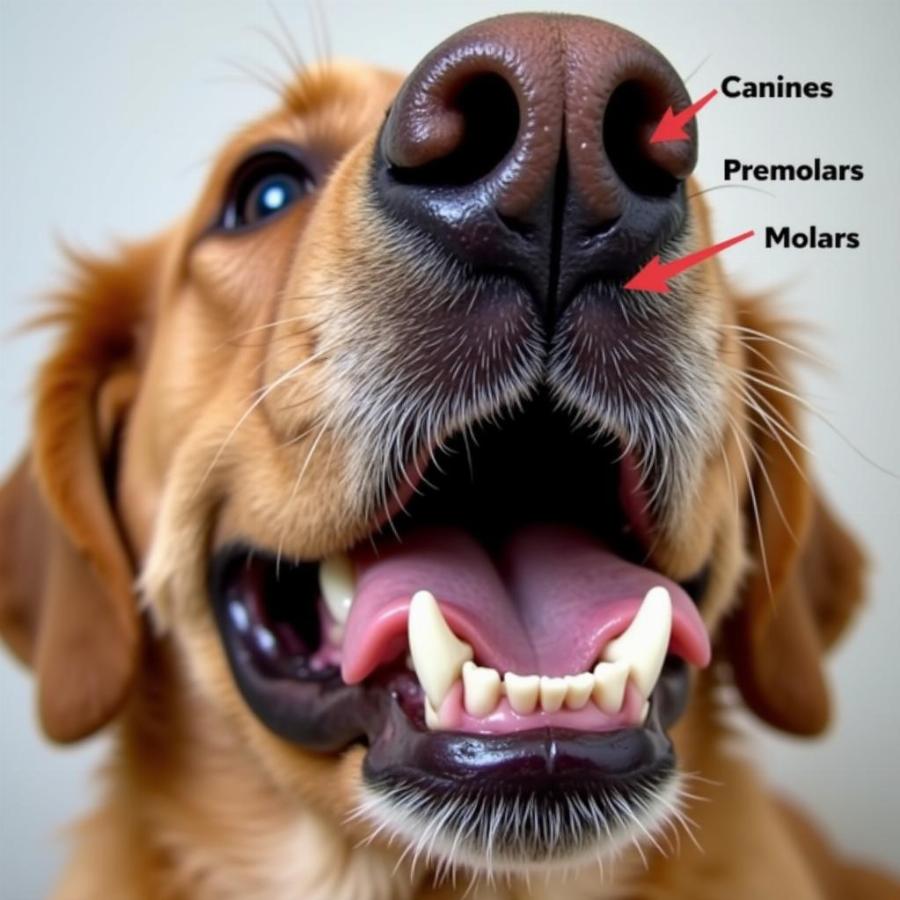A dog’s mouth is a fascinating and complex part of their anatomy. It’s responsible for everything from eating and drinking to playing fetch and showing affection. Understanding the anatomy of a dog’s mouth can help owners provide better care for their furry friends, spot potential problems early on, and appreciate the intricate design that allows our canine companions to interact with the world around them.
The Tools of the Trade: A Look at Dog Teeth
Just like humans, dogs have different types of teeth that serve specific purposes. Puppies are born without teeth, but by around 6 months of age, they will have a full set of adult teeth.
Types of Dog Teeth and their Functions:
- Incisors: These small teeth are located at the front of the mouth and are used for nibbling, grooming, and picking up small objects.
- Canines: The long, pointed teeth on either side of the incisors are the canines, also known as fangs. These are essential for grabbing, tearing, and holding onto objects, reflecting their ancestral hunting instincts.
- Premolars: Located behind the canines, premolars are used for crushing and grinding food.
- Molars: The largest teeth at the back of the mouth, molars are designed for heavy chewing and grinding, particularly important for dogs with a more varied diet.
 Types of Dog Teeth
Types of Dog Teeth
“Understanding the role each type of tooth plays can help owners identify potential dental problems and seek appropriate veterinary care,” says Dr. Emily Parker, a veterinary dentist with over 15 years of experience.
Beyond the Bite: Exploring Other Parts of a Dog’s Mouth
While teeth are a prominent feature, a dog’s mouth comprises other vital components:
- Tongue: Besides its role in tasting, a dog’s tongue aids in drinking, swallowing, and grooming.
- Gums: The pink tissue surrounding the teeth, healthy gums should be firm and pink. Pale or inflamed gums can indicate dental issues.
- Hard Palate: The bony roof of the mouth, the hard palate, separates the oral cavity from the nasal passages.
- Soft Palate: Located at the back of the roof of the mouth, the soft palate helps prevent food from entering the nasal passages during swallowing.
- Salivary Glands: These glands produce saliva, which helps lubricate food for swallowing, aids in digestion, and possesses antibacterial properties.
Common Dental Issues in Dogs
Just like us, dogs are prone to dental problems. Regular dental care is crucial for maintaining their overall health. Some common issues include:
- Plaque and Tartar Buildup: Plaque, a sticky film, can harden into tartar, leading to gum disease and tooth decay.
- Gingivitis: Inflammation of the gums, often caused by plaque buildup.
- Periodontal Disease: A serious gum infection that can damage gums, teeth, and even affect a dog’s overall health.
- Broken Teeth: Chewing on hard objects can lead to chipped or broken teeth.
Maintaining Your Dog’s Oral Health
Regular brushing with a dog-specific toothpaste, providing dental chews, and scheduling professional cleanings are essential for keeping your furry friend’s mouth healthy.
Remember, a healthy mouth translates to a happy dog!
FAQs about Dog Mouth Anatomy
Q: How many teeth do adult dogs have?
A: Adult dogs typically have 42 teeth.
Q: Why does my dog’s breath smell bad?
A: Bad breath can be a sign of dental disease, so it’s essential to consult your veterinarian.
Q: Can I use human toothpaste on my dog?
A: No, human toothpaste contains ingredients that are toxic to dogs.
Q: How often should I brush my dog’s teeth?
A: Ideally, daily brushing is recommended, but even a few times a week can be beneficial.
Q: What are some signs of dental problems in dogs?
A: Bad breath, drooling, difficulty eating, pawing at the mouth, and red or swollen gums are all potential signs of dental problems.
Looking for more information on dog anatomy and care? Check out these related articles:
For all your dog-related needs and expert advice, visit Beaut Dogs**. When you need a helping paw, reach out to us at [email protected] for detailed and accurate answers to all your questions. Beaut Dogs is your trusted resource for all things canine, providing reliable and insightful information about the world of dogs.